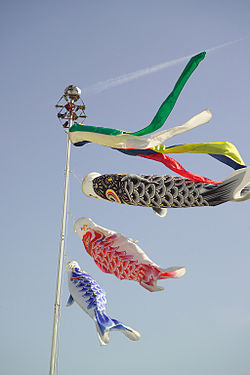Kodomo no hi ( Jap. 子 供 の 日 , Children's Day) is a Japanese national holiday , celebrated annually on May 5 , is part of the Golden Week , the holiday received national status in 1948 .
| Kodomo no hee | |
|---|---|
| date | |

Holiday History
Initially, the holiday was called Tango no Sakku ( Jap. の の 節 句 - the holiday of the first day of the horse) and was celebrated on the fifth day of the fifth moon on the lunar or Chinese calendar. Another name for the holiday is Shёbu no Sekku Празд Iris Holiday. Iris flower symbolizes valor and success.
Before the Second World War, this holiday was called “The Day of the Boys”. Currently, the holiday is known under the name "Children's Day". In 1948, the government of Japan, by decree, secured the status of a national holiday for the holiday.
Holiday Traditions
Before “Children's Day”, Japanese families hang out on a pole in front of the koinobori house - colorful flags in the shape of carps , the number of flags depends on the number of boys in the family. In Japan, carp is considered a symbol of resilience and courage for its ability to swim even against a strong current.
On a special shelf covered with green cloth , Gogatsu-Ningyo dolls are exhibited - traditional Japanese dolls depicting samurai in armor .
Children's Day is celebrated with the whole family, special songs are traditionally performed.
See also
- Hinamatsuri - “Girls Day”
- Japanese holidays
- Children's Day
Links
- "Children's Day" on the site Calend.ru
- "Kodomo no Hee" on the website Nihon.ru
- <Codemo no Hee> on the site Ria.ru